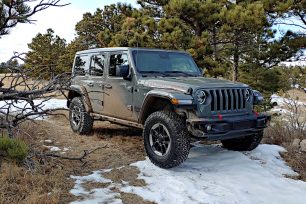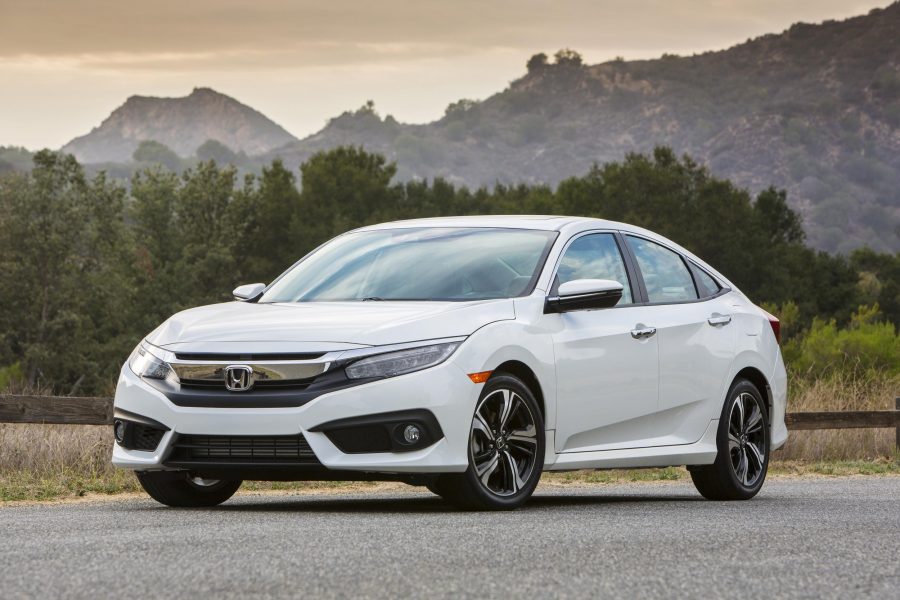Which is best and which should you choose?
Before Subaru and Audi pioneered all-wheel drive in the early 80s , the only option for driving all four wheels was an off-road focused four-wheel drive system , available on SUVs and pickup trucks that sacrificed comfort for capability . Now all-wheel and four-wheel drive systems have proliferated throughout the market; everything from the compact Mazda3 to the Mercedes S-Class offer some form of all-wheel traction.Still, for all its popularity, the merits of all-wheel drive and four-wheel drive remain poorly understood, and confusion surrounds what, if any, differences exist between AWD and 4WD.
To provide a better understanding of these two drivetrain types, we’ve hashed out the differences between them. Read on to learn more about these two typical all-weather layouts and which might be the right choice for you. If you're more suited for two-wheel driving with front-wheel drive (FWD) or rear-wheel-drive, you can check out our other article about RWD vs. FWD.
All-Wheel Drive (AWD)
This is the newest of all the drive types by a wide margin. Even twenty years ago, all-wheel drive was still a novelty. But today more and more cars and crossovers are offering it as an option. Many have come to feel that it is an indispensable option.All-wheel drive does exactly what its name suggests: it sends power to all four wheels. There is hardware at both ends to deliver the power to the wheels. The AWD systems differ somewhat from manufacturer to manufacturer: some automakers have a constant, full-time 50:50 power split to the front and rear, others have systems that constantly vary the power split, and others send power to the rear wheels in only the most adverse conditions.
However the power is divvied up between the wheels, having that all-wheel traction can be a lifesaver in bad weather. If a front-drive or rear-drive car gets in a predicament where both driven wheels can’t get traction, you’re stuck. But in an all-wheel drive car this isn’t as much of an issue: if the fronts are slipping, more power will be sent to the rears; if the rears slip, the fronts will do the work. With all four wheels receiving some amount of power, it’s much easier to overcome slick conditions and get moving.
A common trap to fall into is a false sense of confidence in all-wheel drive in the winter. It will get you going and even help keep you from spinning out in a straight line but it won’t help you stop or turn. Physics does not care whether you drive or a Subaru or a Mustang; if you’re going too fast in bad weather you’ll be in a snowbank soon enough. This isn’t a lesson you want to learn firsthand.
In performance circles, all-wheel drive is respected because it can launch from a stop without any wheelspin. The extra grip also helps with cornering compared to a two-wheel drive car. It’s these reasons that make sports cars like the Nissan GTR such a force to be reckoned with.
The biggest drawback to all-wheel drive is gas mileage. The extra weight of the hardware as well as the additional driveline friction almost always result in all-wheel drive models having worse gas mileage than their front-drive or rear-drive counterparts.
You’ll also spend more money for the comfort of all-wheel drive. For most cars, it costs another $2,000-$3,000 or so to upgrade to all-wheel drive. It’s pricey enough to warrant second thoughts when making final selections on a new car order sheet.
Four Wheel Drive (4WD)
Some might be tempted to interchange the term all-wheel drive with four-wheel drive . This would technically be inaccurate - though they can both send power to all four wheels there’s a distinct difference between the two. That difference is what’s called a transfer case - a gearbox containing another set of gears that’s located alongside the normal transmission. This secondary gearbox essentially allows for a different set of gear ratios. These alternative ratios are designed to provide gearing for extreme conditions, such as driving in heavy mud, sand, or snow.This is why four-wheel drive vehicles have a 4-hi and 4-lo selector - the options refer to the high and low gear ranges. Four-wheel drive can also decouple the front axle completely in the 2-hi setting. This is the recommended setting for ordinary driving. Vehicles so equipped have what’s known as part-time four-wheel drive - four-wheel drive when you need it, and rear-wheel drive for all other instances. This is better for fuel economy and wear and tear. A full-time four-wheel drive system only offers 4-hi and 4-lo; there is no option to disconnect the front axle completely.
All this flexibility is what makes four-wheel drive so potent off-road. With its transfer case and low-range gearset, 4WD vehicles can get through nearly terrain, especially if they’re running dedicated mud or all-terrain tires. There’s serious capability in four-wheel drive rigs; it’s why Toyota 4Runners and Jeep Wranglers are such favorites in the off-roading crowd.
Where four-wheel drive suffers is in day-to-day livability. Unless your commute takes you through the Moab Jeep trails, the drawbacks of 4WD systems showcase themselves splendidly when you’re regularly driving to the office. Bad gas mileage, long braking distances, ponderous handling, and a generally unrefined driving experience have long been common complaints about four-wheel drive vehicles. The latest iterations of these vehicles have mitigated some of these grievances - a modern F-150 or Chevrolet Silverado with 4WD rides like a Cadillac compared to their ancestors - but it remains the most focused and least comfortable of the drive types.
Which States Have the Most 4WD and AWD Vehicles?
States With the Most 4WD and AWD Vehicles
| iSeeCars States With the Most 4WD and AWD Vehicles | ||
| Rank | State | % AWD+4WD |
| 1 | Montana | 71.8% |
| 2 | Alaska | 70.9% |
| 3 | Wyoming | 70.1% |
| 4 | North Dakota | 67.8% |
| 5 | Vermont | 67.8% |
| 6 | South Dakota | 66.1% |
| 7 | West Virginia | 65.7% |
| 8 | Maine | 65.7% |
| 9 | Colorado | 64.7% |
| 10 | Idaho | 63.4% |
Montana is the state with the most 4WD or AWD vehicles, with 71.8% of the vehicles on the road having more than a two-wheel drive type. “‘Montana’ translates to ‘mountain’ in Spanish and has over 100 mountain ranges within its boundaries as well as many dirt roads,” said iSeeCars CEO Phong Ly. “The state receives snow most months of the year, leaving roads snowy or icy, which helps explain why these all-weather vehicles are so popular.”
Four states that border Montana also make the list including third-ranked Wyoming, fourth-ranked North Dakota, sixth-ranked South Dakota, and tenth-ranked Idaho. “Similar to Montana, Wyoming and Idaho are very mountainous with similar terrains and weather,” said Ly. “Meanwhile North and South Dakota are also subjected to extreme winters with frequent blizzards.”
Remaining states include additional mountainous states: Alaska, West Virginia, Colorado, and Vermont and Maine.
Breakdown of AWD Vs. 4WD
| Breakdown of AWD Vs. 4WD | |||
| Rank | State | 4WD | AWD |
| 1 | Montana | 46.0% | 25.8% |
| 2 | Alaska | 40.8% | 30.1% |
| 3 | Wyoming | 48.5% | 21.6% |
| 4 | North Dakota | 41.6% | 26.2% |
| 5 | Vermont | 32.8% | 35.0% |
| 6 | South Dakota | 38.4% | 27.7% |
| 7 | West Virginia | 36.3% | 29.4% |
| 8 | Maine | 29.8% | 35.9% |
| 9 | Colorado | 29.2% | 35.5% |
| 10 | Idaho | 39.6% | 23.8% |
Among these mountainous states with harsh winters, all but three states prefer 4WD vehicles. The exceptions which have more AWD vehicles than 4WD are Vermont, Maine, and Colorado. This suggests that drivers in these states prefer crossovers and AWD sedans over rugged off-road vehicles.
“Vermont, Maine, and Colorado are eco-friendly states, and as AWD vehicles tend to be more fuel-efficient than their 4WD counterparts, it’s no surprise that drivers in these states are more likely to choose AWD vehicles,” said Ly. “Subarus, which offer standard AWD, are very popular in these states, which could help play a role in these high percentages.”
States with the Fewest 4WD and AWD Vehicles
| iSeeCars States With the Least 4WD and AWD Vehicles | ||
| Rank | State | % AWD+4WD |
| 1 | Florida | 17.4% |
| 2 | Hawaii | 18.2% |
| 3 | Louisiana | 18.5% |
| 4 | California | 20.5% |
| 5 | Mississippi | 21.4% |
| 6 | Alabama | 21.7% |
| 7 | Texas | 22.0% |
| 8 | Georgia | 23.2% |
| 9 | Arizona | 23.9% |
| 10 | South Carolina | 24.2% |
4WD- and AWD Vehicles By State (Complete List)
Here are the complete results for all fifty states and Washington, D.C:
| iSeeCars Complete Ranking of AWD+4WD Vehicles by State | ||
| Rank | State | % AWD+4WD |
| 1 | Montana | 71.8% |
| 2 | Alaska | 70.9% |
| 3 | Wyoming | 70.1% |
| 4 | North Dakota | 67.8% |
| 5 | Vermont | 67.8% |
| 6 | South Dakota | 66.1% |
| 7 | West Virginia | 65.7% |
| 8 | Maine | 65.7% |
| 9 | Colorado | 64.7% |
| 10 | Idaho | 63.4% |
| 11 | New Hampshire | 62.9% |
| 12 | Massachusetts | 61.0% |
| 13 | Connecticut | 60.2% |
| 14 | Minnesota | 59.8% |
| 15 | New York | 58.8% |
| 16 | Nebraska | 57.6% |
| 17 | Pennsylvania | 56.6% |
| 18 | Rhode Island | 55.5% |
| 19 | Wisconsin | 54.9% |
| 20 | Utah | 54.3% |
| 21 | New Jersey | 53.9% |
| 22 | Iowa | 53.8% |
| 23 | Oregon | 52.3% |
| 24 | Washington | 51.5% |
| 25 | Michigan | 50.1% |
| 26 | Delaware | 47.6% |
| 27 | Virginia | 44.4% |
| 28 | Maryland | 44.2% |
| 29 | Illinois | 43.9% |
| 30 | Ohio | 43.6% |
| 31 | Indiana | 42.5% |
| 32 | Kentucky | 42.1% |
| 33 | Missouri | 41.7% |
| 34 | Kansas | 40.6% |
| 35 | New Mexico | 37.7% |
| 36 | Arkansas | 35.3% |
| 37 | Oklahoma | 33.2% |
| 38 | Tennessee | 33.0% |
| 39 | North Carolina | 32.7% |
| 40 | Nevada | 29.7% |
| 41 | Washington, D.C. | 28.5% |
| 42 | South Carolina | 24.2% |
| 43 | Arizona | 23.9% |
| 44 | Georgia | 23.2% |
| 45 | Texas | 22.0% |
| 46 | Alabama | 21.7% |
| 47 | Mississippi | 21.4% |
| 48 | California | 20.5% |
| 49 | Louisiana | 18.5% |
| 50 | Hawaii | 18.2% |
| 51 | Florida | 17.4% |
The Bottom Line
It must be said that four-wheel drive should be thought of as a specialty drivetrain, in the sense that it often sacrifices fuel economy and ride quality for traction and off-road capability. The traits that make 4WD unstoppable when off-roading are at direct odds with the traits that make for a good road car, so the best four-wheel drivers are usually found to be less livable on dry pavement than most buyers anticipate.
If you’re considering a four-wheel drive vehicle, think about how badly you want that capability and if all-wheel drive might not be the better option. The daily commute is a lot more livable in a Subaru Outback than a Jeep Wrangler, regardless of how cool the Jeep looks. Also take into account your terrain and weather conditions to decide if 4WD is truly necessary.
As for all-wheel drive, we’d be more likely to recommend front-wheel drive, particularly for those living outside the snowbelt. With its worse gas mileage and higher initial purchase price, you will be paying for that all-wheel luxury over the course of ownership, and its importance is often overblown. A front-drive car with a good set of winter tires will likely have no issue performing the same feats as an all-wheel car on all-season tires.
This doesn’t mean all-wheel drive is useless - it is certainly beneficial, and for some buyers it is indeed indispensable. AWD vehicles are more necessary in places where the snow piles up, the road conditions are rough, and the grades are steep. For the rest of us, snow tires on a front-driver will do the trick just fine.
If you’re looking for a car, you can search over 4 million new and used cars with iSeeCars’ award-winning car search engine that helps shoppers find the best car deals by providing key insights and valuable resources, like the iSeeCars VIN check report. You can compare deals by your chosen drive type or compare vehicles across all drive types.
Methodology
iSeeCars.com analyzed over 11 million vehicles in the 50 US states and the District of Columbia between January and August of 2019. The drive type of each car was tabulated to calculate the share of each drive type within each state.
About iSeeCars.com

































































